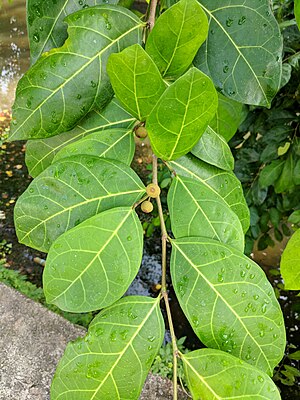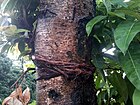Note: This is a project under development. The articles on this wiki are just being initiated and broadly incomplete. You can Help creating new pages.
Difference between revisions of "Ficus tinctoria - Goddumitle"
(→External Links) |
|||
| (3 intermediate revisions by the same user not shown) | |||
| Line 1: | Line 1: | ||
[[File:Ficus sp 59.jpg|thumb|right|''Goli'', ''Ficus tinctoria'']] | [[File:Ficus sp 59.jpg|thumb|right|''Goli'', ''Ficus tinctoria'']] | ||
| − | ''' | + | '''Ficus tinctoria''' is a very variable evergreen plant. It grows upto 1 metre tall. At other times a small tree but more commonly becoming a large tree with a spreading crown that can grow up to 25 metres tall. The bole can be 300cm in diameter. |
| − | |||
==Uses== | ==Uses== | ||
| − | + | {{Uses|Weakness}}, {{Uses|Dressing for Broken bones}}.<ref name="Uses"/> | |
==Parts Used== | ==Parts Used== | ||
| − | + | {{Parts Used|Fruits}}. | |
==Chemical Composition== | ==Chemical Composition== | ||
| + | <ref name="chemical composition"/> | ||
==Common names== | ==Common names== | ||
| − | {{Common names|kn= | + | {{Common names|kn=Aane gulaganji|ml=Manjadi|sa=Kamboji, Ksharaka, Kucandanah,Tamraka|ta=Aanaikundrimani, Anai kundumani|te=Bandi gurivenda, Bandi gurvina, Bandigurivenda, Bandiguruginja, Enugaguruginji|hi=Baragunci, Barighumchi, Barigumchi|en=Coralwood tree}} |
| − | |||
==Properties== | ==Properties== | ||
| Line 35: | Line 34: | ||
==Identification== | ==Identification== | ||
===Leaf=== | ===Leaf=== | ||
| − | {{Leaf|Simple| | + | {{Leaf|Simple|Alternate|Stipules lateral, to 1.5 cm, lanceolate; petiole 5-10 mm, slender, grooved above, scabrous.}}<ref name="Leaf"/> |
===Flower=== | ===Flower=== | ||
| − | {{Flower|Unisexual|Syconia||1| | + | {{Flower|Unisexual|Syconia||1|Axillary, usually paired or clustered, rarely solitary, globose.}} |
===Fruit=== | ===Fruit=== | ||
| − | {{Fruit|Syconium|| | + | {{Fruit|Syconium||Yellow when ripe; peduncle to 1.5 cm long; achene 1.5 x 1.2 mm, keeled or not||}} |
===Other features=== | ===Other features=== | ||
| Line 47: | Line 46: | ||
==List of Ayurvedic medicine in which the herb is used== | ==List of Ayurvedic medicine in which the herb is used== | ||
| + | ==Where to get the saplings== | ||
| − | |||
==Mode of Propagation== | ==Mode of Propagation== | ||
| − | {{Propagation|Seeds}}, {{Propagation|Cuttings}}. | + | {{Propagation|Seeds}}, {{Propagation|Cuttings}}, {{Propagation|Air layering}}. |
==How to plant/cultivate== | ==How to plant/cultivate== | ||
| − | + | The plant usually produces fruit all year round.<ref name="How to plant/cultivate"/> | |
| − | |||
| − | = | ||
| − | |||
| − | |||
| − | |||
| − | |||
| − | |||
==Commonly seen growing in areas== | ==Commonly seen growing in areas== | ||
| − | {{Commonly seen|Tropical area}}. | + | {{Commonly seen|Tropical area}}, {{Commonly seen|Moist valleys}}, {{Commonly seen|On rocks}}, {{Commonly seen|Thickets}}. |
==Photo Gallery== | ==Photo Gallery== | ||
<gallery class="left" caption="" widths="140px" heights="140px"> | <gallery class="left" caption="" widths="140px" heights="140px"> | ||
| − | + | Ficus lacor 02.jpg | |
| − | + | Ficus lacor.jpg | |
| − | |||
</gallery> | </gallery> | ||
==References== | ==References== | ||
| − | |||
<references> | <references> | ||
| + | <ref name="chemical composition">[Chemistry]</ref> | ||
| − | <ref name="Leaf">[ | + | <ref name="Leaf">[Morphology]</ref> |
| − | |||
| − | |||
| + | <ref name="How to plant/cultivate">[http://tropical.theferns.info/viewtropical.php?id=Ficus+tinctoria Cultivation]</ref> | ||
| + | <ref name="Uses">Indian Medicinal Plants by C.P.Khare</ref> | ||
</references> | </references> | ||
==External Links== | ==External Links== | ||
| − | * | + | * [https://www.easyayurveda.com/2017/05/23/java-fig-ficus-lacor-plaksha/ Ficus lacor on easyayurveda.com] |
| + | * [http://www.flowersofindia.net/catalog/slides/Dye%20Fig.html Ficus tinctoria on flowersofindia.net] | ||
| + | |||
[[Category:Herbs]] | [[Category:Herbs]] | ||
| − | [[Category: | + | [[Category:Pages without herbs images]] |
| − | |||
Latest revision as of 17:37, 21 May 2020
Ficus tinctoria is a very variable evergreen plant. It grows upto 1 metre tall. At other times a small tree but more commonly becoming a large tree with a spreading crown that can grow up to 25 metres tall. The bole can be 300cm in diameter.
Contents
- 1 Uses
- 2 Parts Used
- 3 Chemical Composition
- 4 Common names
- 5 Properties
- 6 Habit
- 7 Identification
- 8 List of Ayurvedic medicine in which the herb is used
- 9 Where to get the saplings
- 10 Mode of Propagation
- 11 How to plant/cultivate
- 12 Commonly seen growing in areas
- 13 Photo Gallery
- 14 References
- 15 External Links
Uses
Weakness, Dressing for Broken bones.[1]
Parts Used
Chemical Composition
Common names
| Language | Common name |
|---|---|
| Kannada | Aane gulaganji |
| Hindi | Baragunci, Barighumchi, Barigumchi |
| Malayalam | Manjadi |
| Tamil | Aanaikundrimani, Anai kundumani |
| Telugu | Bandi gurivenda, Bandi gurvina, Bandigurivenda, Bandiguruginja, Enugaguruginji |
| Marathi | NA |
| Gujarathi | NA |
| Punjabi | NA |
| Kashmiri | NA |
| Sanskrit | Kamboji, Ksharaka, Kucandanah,Tamraka |
| English | Coralwood tree |
Properties
Reference: Dravya - Substance, Rasa - Taste, Guna - Qualities, Veerya - Potency, Vipaka - Post-digesion effect, Karma - Pharmacological activity, Prabhava - Therepeutics.
Dravya
Rasa
Tikta (Bitter)
Guna
Laghu (Light)
Veerya
Sheeta (cold)
Vipaka
Karma
Pitta
Prabhava
Habit
Identification
Leaf
| Kind | Shape | Feature |
|---|---|---|
| Simple | Alternate | Stipules lateral, to 1.5 cm, lanceolate; petiole 5-10 mm, slender, grooved above, scabrous. |
Flower
| Type | Size | Color and composition | Stamen | More information |
|---|---|---|---|---|
| Unisexual | Syconia | 1 | Axillary, usually paired or clustered, rarely solitary, globose. |
Fruit
| Type | Size | Mass | Appearance | Seeds | More information |
|---|---|---|---|---|---|
| Syconium | Yellow when ripe; peduncle to 1.5 cm long; achene 1.5 x 1.2 mm, keeled or not | {{{6}}} |
Other features
List of Ayurvedic medicine in which the herb is used
Where to get the saplings
Mode of Propagation
Seeds, Cuttings, Air layering.
How to plant/cultivate
The plant usually produces fruit all year round.[4]
Commonly seen growing in areas
Tropical area, Moist valleys, On rocks, Thickets.
Photo Gallery
References
- ↑ Indian Medicinal Plants by C.P.Khare
- ↑ [Chemistry]
- ↑ [Morphology]
- ↑ Cultivation
External Links
- Ayurvedic Herbs known to be helpful to treat Weakness
- Ayurvedic Herbs known to be helpful to treat Dressing for Broken bones
- Herbs with Fruits used in medicine
- Herbs with common name in Kannada
- Herbs with common name in Hindi
- Herbs with common name in Malayalam
- Herbs with common name in Tamil
- Herbs with common name in Telugu
- Herbs with common name in Sanskrit
- Herbs with common name in English
- Habit - Small tree
- Index of Plants which can be propagated by Seeds
- Index of Plants which can be propagated by Cuttings
- Index of Plants which can be propagated by Air layering
- Herbs that are commonly seen in the region of Tropical area
- Herbs that are commonly seen in the region of Moist valleys
- Herbs that are commonly seen in the region of On rocks
- Herbs that are commonly seen in the region of Thickets
- Herbs
- Pages without herbs images


